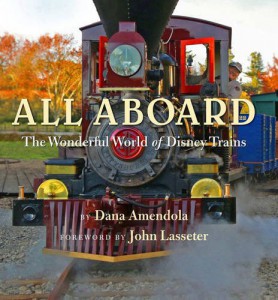All Aboard – The Wonderful World of Disney Trains Book Review
 The latest coffee table book from Disney Press aimed at adult fans is All Aboard - The Wonderful World of Disney Trains by Dana Amendola. Dana has a long history with the company working in Disney Theatrical, but his true passion is trains, which is made evident by a heartwarming anecdote from his childhood within the first few pages. If you're a Disney history buff, this book features some facts I had never read before elsewhere.
The latest coffee table book from Disney Press aimed at adult fans is All Aboard - The Wonderful World of Disney Trains by Dana Amendola. Dana has a long history with the company working in Disney Theatrical, but his true passion is trains, which is made evident by a heartwarming anecdote from his childhood within the first few pages. If you're a Disney history buff, this book features some facts I had never read before elsewhere.
After a forward by train enthusiast John Lasseter and Dana's introduction comes the first chapter, "Keep Moving Forward," which is about how Walt Disney came to be fascinated with trains while growing up in Marceline, MO. It goes into greater detail about his first job as a news butcher and the connections he made. In this chapter, you get the sense that Walt learned how to win people over during this short time, a skill that would help him make impossible dreams a reality. The next chapter is a familiar story to most Disney fans, "Born on a Train" covers the creation of Mickey Mouse on Walt's train ride from New York City to Los Angeles after losing the rights to Oswald the Lucky Rabbit. Many Disney historians have a difference of opinion over who truly invented Mickey, Walt of Ub Iwerks, but this chapter supports the Walt version.
The third chapter is the meatiest part of the book, "Trains in Disney Films." It's a detailed look at all of the trains that have ever appeared in Disney films starting with a 1927 Oswald short called Trolly Troubles and going to as recent as 2014 with Planes Fire & Rescue (the Train of Thought from Inside Out is not included). With great pictures and even some behind the scenes sections, Amendola sheds some great insight for Disney film buffs. Some of the films also include a section called "Inside Track" with some fantastic little-known information about the history of the trains. Amendola did an incredible amount of research while assembling this book.
My favorite section of the book is called "Four Men, Four Trains," which focuses on the personal collections of Walt Disney, Ward Kimball, Ollie Johnston and John Lasseter. I thought I knew a lot about Walt's backyard miniature ride-on train, the Lilly Belle, but I surprisingly learned a lot from this section. I haven't seen a lot published about Ward Kimball's or Ollie Johnston's trains and the two sections about their backyard railroad empires were fantastic (I first learned about them at the Walt Disney Family Museum's temporary exhibit "All Aboard: A Celebration of Walt's Trains"). Ollie's section is quite sad and emotional, but a happy ending comes when you find out how John Lasseter paid tribute to his animation mentor by restoring his train and still takes care of it today.
Disney Park fans hoping to get more insight into the trains that circle the Magic Kingdom's around the world will be thrilled by "Behind the Roundhouse. It provides extensive detail behind each locomotive at every Disney Park, the only noticeable omission being the Fort Wilderness Railroad. If you're curious to know the history behind each locomotive as well as some anecdotes from the engineers that drive them every day, this section is for you. The final section is called "Trains in the American Vernacular" and gives definition of some common, every day phrases that you probably never knew originated from trains, such as the word "crummy."
I thoroughly enjoyed reading All Aboard. I'm not a trains enthusiast, but as a Disney fan I love the Disney trains and learning about the passion projects of some of the legends that made and continue to make the company great. This book surprisingly has quite a few grammatical errors that were missed by the editor and there is a mention of animation for Planes being done by Pixar which seemed inaccurate (Disney Toon Studios made those films), but these errors didn't distract from the wonderful stories and histories within. It has some wonderful pictures as well and will surely be a welcome addition to your Disney book library.
